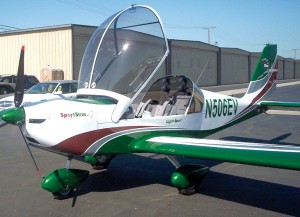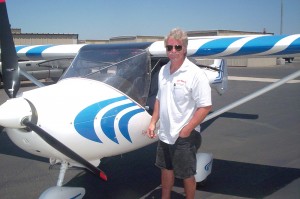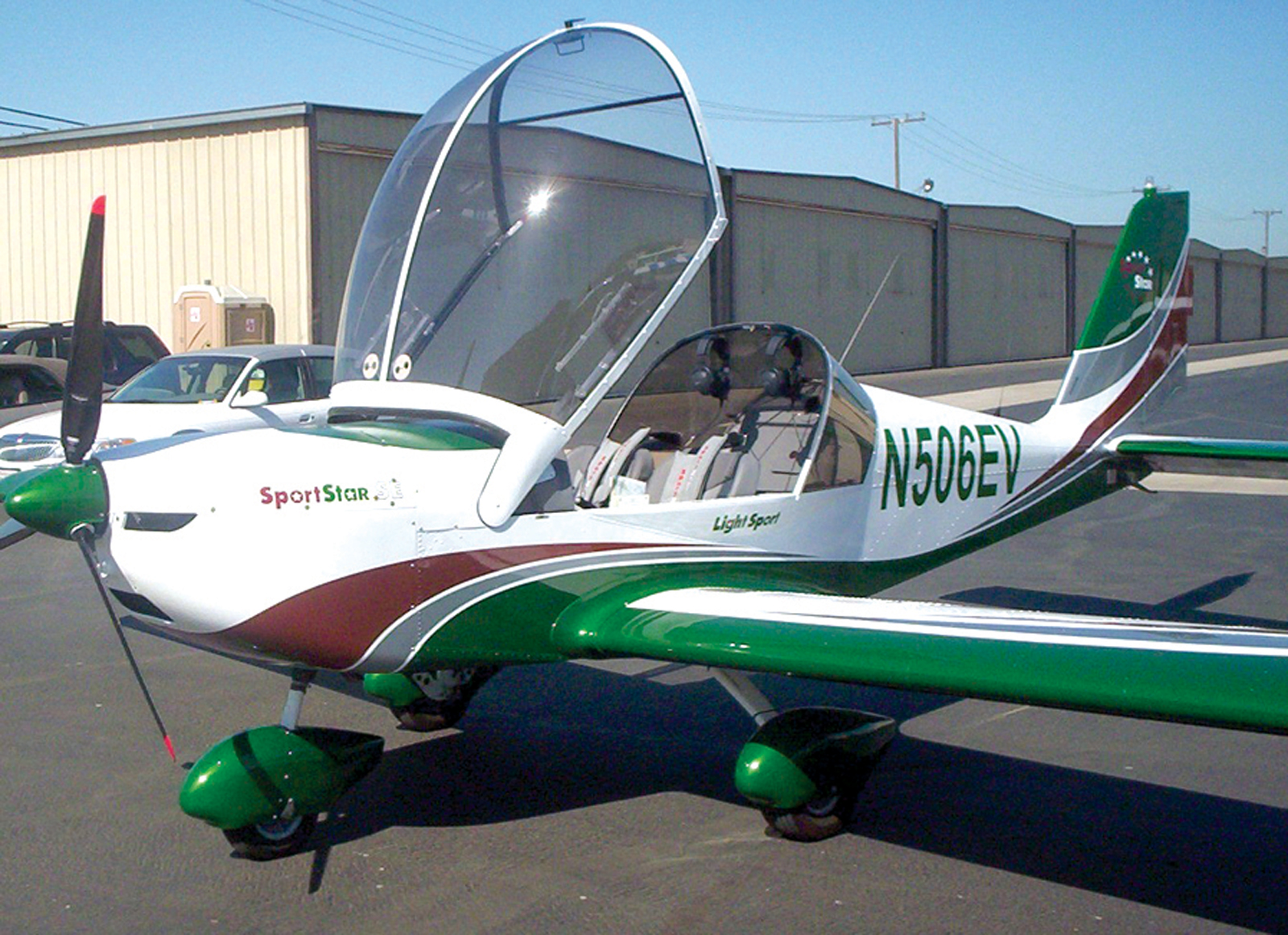By Fred “Crash” Blechman
Recently, at a monthly meeting of the Experimental Aircraft Association Chapter #723 at Camarillo Airport, two light sport aircraft were flown in from Sport Planes West at Hemet, Calif., for chapter members and guests to inspect. I had already made arrangements with Fred Parle, owner of Sport Planes West, to get a demo flight in one of these planes.

The lift-up bubble canopy offers excellent visibility and easy entrance into the cockpit of the all-metal SportStar. The aircraft is sold by Sport Planes West, and will soon be available in Camarillo.
Since the FAA approved the requirements for the new sport pilot license and light-sport aircraft, I’ve made it a point to get familiar with both. Although I have long been a member of EAA Chapter #723, I’ve also recently joined EAA National, in order to receive EAA Sport Pilot & Light Sport Aircraft magazine. Earlier this year, I flew a Kappa KP-5 LSA being sold by Orange Country Sport Planes. I was very impressed!
I’m now 79 years old, and most of my piloting experience is from flying Navy SNJs and F4U Corsairs in the early 1950s. However, in recent years, I’ve flown a variety of aircraft, including the Goodyear blimp, several ultralights, sailplanes and even a gyroplane. When I say “flying,” I mean “in the air”—no landing or takeoffs, since I haven’t had a valid aviation medical certificate for more than 50 years. I seriously doubt I could pass an FAA flight physical now. I’ve become known as “The Flying Hobo,” since I have to “bum rides” from pilots.
However, the new sport pilot license doesn’t require passing an FAA medical exam. You need only a valid driver’s license. For those who’ve had a prior pilot license, a minimum of only four hours of dual instruction and an oral and written test are required to qualify for a sport pilot license. This license then allows you to fly any of the many light-sport aircraft that are becoming available.
Back to my story about flying one of the Sport Planes West aircraft. Before the meeting, Fred arrived in his beautiful low-wing SportStar at the EAA #723 hangar, together with Tom Asinof in his sleek high-wing Allegro 2000. Both of these gentlemen have had extensive piloting experience.
Fred has built more than 130 ultralight aircraft, has more than 20,000 hours of piloting and flight instruction experience, and recently formed Sport Planes West at Hemet-Ryan Airport to sell light-sport aircraft. He’s presently a dealer for six light-sport aircraft, Evektor’s SportStar, Fantasy Air’s Allegro 2000, Flight Design’s CT and three Urban Air aircraft: the Lambada motor glider, the Samba and the Samba XXL gliders.
Tom bought the Allegro 2000 from Sport Planes West last November, and had flown it more than 100 hours, usually commuting between Hemet and Tehachapi. He has 5,000 hours as a pilot in twin Beeches, DC-3s, ultralights and miscellaneous other aircraft, and is an ultralight instructor. He also owns two ultralights, a two-place Beaver RX-550 and a single-seat Titan Tornado, both based at Perris Airport.
Many of the 80 meeting attendees inspected the planes. When the sport pilot rule came out, the general impression was that the light-sport aircraft available to fly with this license would be ultralights, powered parachutes and such. Not true! Even though some LSAs are available as 200-hour quick-build kits, these two LSAs—like most being imported from foreign countries that have had this type of sport pilot license for years—are “real” aircraft, capable of flying up to 138 miles an hour for long distances, with low fuel consumption. Although restricted to VFR daytime flying only, and limited to one pilot and one passenger, LSAs offer great travel and sport flying flexibility.
The SportStar has an all-metal anodized and corrosion-proof aluminum airframe, using bonded and riveted construction. The wingspan is just less than 28 feet. It features a large lift-up unobstructed bubble canopy, offering all-around visibility, and the spacious cockpit has upholstered seats and dual joysticks. It cruises at 125 miles an hour and stalls at 45 miles an hour, with large flaps. The typical fuel consumption of the 100-hp Rotax 912 ULS engine is around four gallons per hour, with a typical range of 700 nautical miles.

Tom Asinof bought his Allegro 2000 from Sport Planes West last November. He had flown it well over 100 hours when this photo was taken in June.
As the meeting started, most members and guests went inside the hangar, which had been cleared for seating. James Parle, Fred’s son, showed photos and described the aircraft available from Sport Planes West. He explained that they have made arrangements with FBO Channel Islands Aviation at Camarillo Airport to be dealers for light-sport aircraft. Afterwards, Fred Parle answered questions from the group.
As the meeting moved on to another speaker, Fred told me that Tom would take me for a demo flight in Tom’s Allegro 2000, which has a composite fuselage with all-metal wings, tail plane and rudder. The interior sports two comfortable, side-by-side, upholstered seats, behind which is a small baggage area. Two large Lexan doors and a blue-hue Lexan overhead provide a panoramic view. Ground handling is provided with a rudder-pedal steerable nosewheel and hydraulic disc brakes, and electrically activated two-position flaps allow a stall speed as low as 40 miles an hour.
With a wingspan of 35 feet, 6 inches, Tom’s Allegro is powered by a 100-hp Rotax 912 S UL engine and a three-bladed propeller. It has a maximum speed of 137 miles an hour, and can fly 350 miles using less than four gallons of fuel per hour. With an empty weight of 628 pounds, it can carry two people averaging 250 pounds each, 22 pounds of baggage and full fuel, for a maximum takeoff weight of 1,232 pounds. It also has a very respectable glide ratio of 12-to-1.
Entry through each side into the Allegro 2000 was easy, with the large upward-lifting doors, and the cockpit wasn’t crowded. A joystick, with transmitter button on top, and a squeeze-handle that operated both main wheel brakes, is positioned between the two seats. The throttle for the left seat is on the left side at seat level, and for the right seat, at the right side at seat level.
The uncluttered instrument panel has a series of toggle switches at the bottom, each with an “ON” light, and easy-to-read conventional gauges for altitude, airspeed, rate of climb, fuel level and fuel pressure. A ball (no needle, since this plane is only for VFR flight) indicates slipping or skidding unbalanced flight. A wet compass at the top of the instrument panel is the only navigational instrument, although Tom has added a Garmin GPS. An LCD digital readout provides engine performance (rpm, temperatures, etc.) and a two-frequency radio with two noise-canceling headsets provides communication.
Tom locked the brakes with the joystick lever, flipped up two guarded toggle switches for the left and right magnetos, and turned the master key to start the engine. He went through the start-up check list, taxied to the run-up area, ran up the engine to 4,000 rpm to check the magnetos, and went over the takeoff check list as we waited behind four other planes for takeoff clearance.
After waiting for several landing aircraft and for the planes ahead of us, we finally received takeoff clearance for the single Runway 26, and we were off the ground in less than 500 feet at 70 mph. We climbed at 90 mph and 800 feet per minute, using 4,700 rpm, into a clear blue sky, with ground visibility over 15 miles. The fertile green fields of the many farms in the highly agricultural Camarillo area scrolled beneath us, and on our right, we passed the parade of cars proceeding west toward Ventura on the 101 Freeway.
I took the controls, banked to the right and immediately noticed the sensitivity of the stick and the stiffness of the rudders. Looking at the ball, it was off to the right, and I had to press right rudder to center it. As we leveled off, I made some S-turns and found I had to use considerable rudder pressure to keep the ball centered. I quickly got used to using rudder pressure in a turn. The flight was smooth and the visibility was outstanding, forward, down and around from the Lexan-enclosed cockpit.
We turned northwest around the mountains east of Santa Paula Airport, leveled off and cruised along at 120 mph until the airport came in sight. Tom took over for a touch-and-go on Runway 22 with a 45-degree right crosswind. I flew us back to Camarillo, where Tom made the approach and landing on Runway 26 into a 45-degree left crosswind, touching down at 50 mph. No problem. The entire flight, from takeoff to landing, was only 20 minutes, and probably used less than two gallons of fuel!
You can reach Tom Asinof at 951-378-5397 or tom.asinof@verizon.net, and Sport Planes West at 951-765-5020 or [http://www.sportplaneswest.com]. Fred “Crash” Blechman’s two flying books, “Bent Wings – F4U Action & Accidents: True Tales of Trial & Terror!” and “Flying With the Fred Baron,” are available at [http://www.amazon.com] or [http://www.bn.com].











